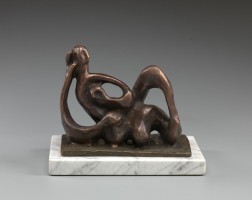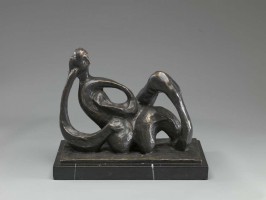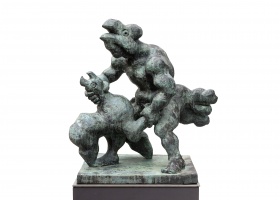

Hagar I (study)
| Author: |
Jacques Lipchitz (1891–1973)  |
| Created: | 1948 |
| Material: | bronze |
| Dimensions: | 13.50 × 8.30 cm |
| Signature: | on the pedestal: 5/2 Jlipchitz |
This sculpture is part of a series based on the Old Testament figure of Hagar, the Egyptian maidservant who bore Abraham’s son Ishmael. When Sarah, who had been barren for many years, finally gave birth to her own child, Isaac, she and Abraham sent Hagar and Ishmael into the wilderness. Lost and despairing, exhausted and thirsty, Hagar heard the voice of an angel, and found a well that saved her. This tale of betrayal, protection and displacement has an immense significance in the origins of Judaism. For Jacques Lipchitz (1891–1973), a Jewish sculptor who was himself forced to flee from Europe and found refuge in America, where he married for the second time, the story of Hagar probably resonated deeply. The timing of his exploration of the theme is significant: he began to work on this subject in 1948 during the Arab-Israeli war. In his autobiography, he describes the theme of Hagar as ‘a prayer for Jewish-Arab brotherhood’. Throughout the late 1940s, he explored the theme of Hagar across various media, including plaster, bronze and drawing. Each piece in the series conveys a sense of tragedy mingled with hope.
Text author Jurgita Ludavičienė
Source: Law firm Valiunas Ellex art album MORE THAN JUST BEAUTY (2012). Compiler and author Giedrė Jankevičiūtė, THE ART OF MATERIALS. Compiler and text author Jurgita LudavičienėExpositions: “More Than Just Beauty: The Image of Woman in the LAWIN collection”, 12 October – 11 November 2012, National Gallery of Art, Vilnius; “Life in Sculpture. Jacques Lipchitz – 125”, 1 July –25 September 2016, The Tolerance Centre of the Vilna Gaon State Jewish Museum, Vilnius.










_web.jpg)